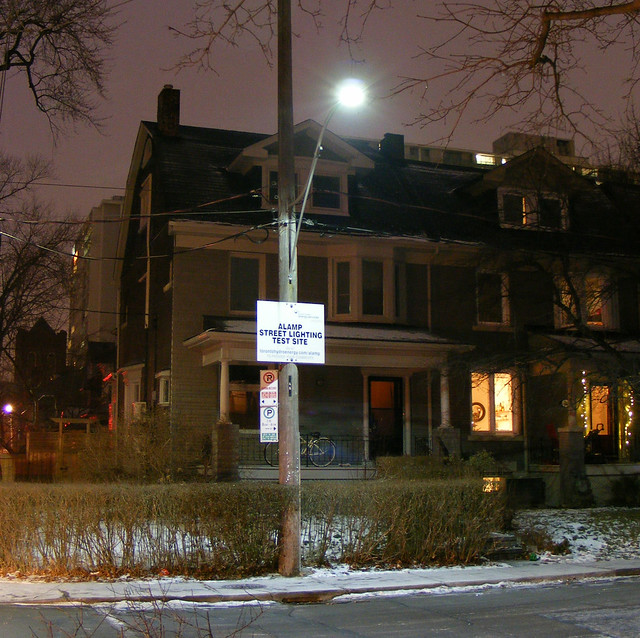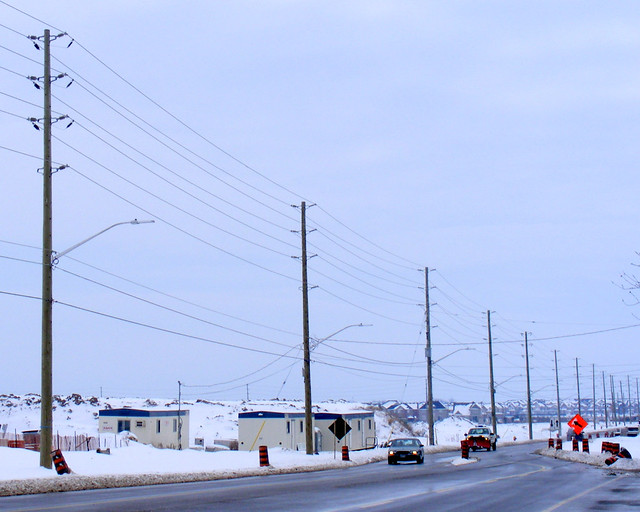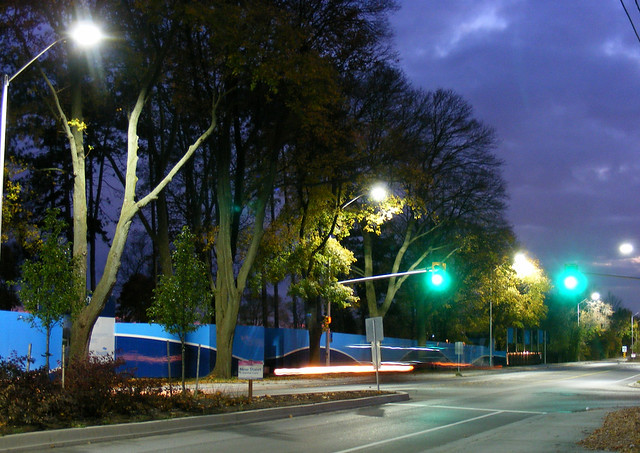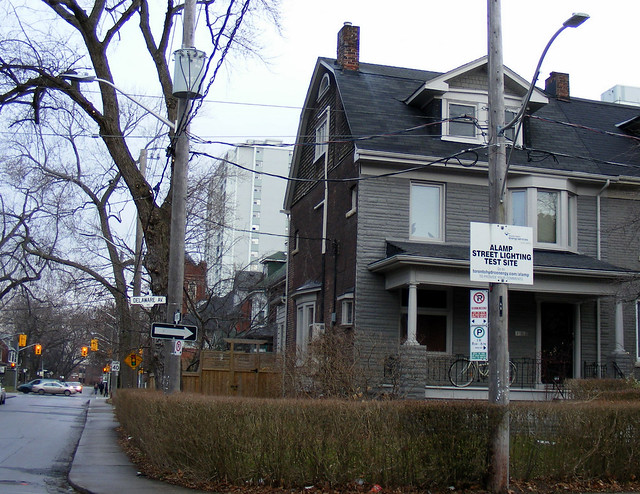The Town of Oakville just completed the reconstruction of Lakeshore Road between Mississaga Road (near the old village of Bronte) and the western municipal boundary at Burloak Avenue. This project included the construction of left-turn and bicycle lanes while maintaining one through lane in each direction. The bicycle lanes on this stretch of Lakeshore Road help to integrate it with the Waterfront Trail, which follows Lake Ontario from Niagara-on-the-Lake to Trenton.
But one of the most interesting aspects of this otherwise routine road reconstruction has been the installation of white LED streetlighting, the first large installation that I know of in the Greater Toronto Area. LED lighting, which offers energy and maintenance savings, has been used in parking lots and some gas stations, but have not been used widely in streetlighting applications.
Toronto Hydro has been testing a few LED lights as part of its ongoing ALAMP light testing program, launched on city streets in 2009. One of these installations is at Hepbourne and Delaware Avenues , in west end Toronto. I have also spotted new installations elsewhere in Halton Region, such as on Bronte Road in Oakville and Tremaine Road in Milton. (Dave Leblanc wrote a good article about the ALAMP program in the Globe and Mail last December)
While the suburban municipalities surrounding Toronto installed mercury vapour lights in the 1960s through the 1980s (in housings known as “cobra heads”), Toronto chose to maintain bright incandescant lamps within the classic “acorn head” housing affixed to a pole by an elegant two-piece curved bracket. In the late 1980s and early 1990s, the bluish-white-burning mercury vapour bulbs were replaced by high-pressure sodium (HPS) lamps while the old City of Toronto preferred white lighting over the beige-orange glow of HPS lamps, replacing its inefficient incandescent lights with metal halide lamps.
One of the challenges of LED lighting is that unlike curved lenses, like the classic acorn heads or modern HPS “cobra heads”, LED panels are flat, making light dispersion more difficult. This is an important to the safety of street users, particularly pedestrians. The pure white light is also brigher and harsher than older sources of streetlighting. However, the ALAMP installation seems to mitigate these drawbacks somewhat.

Night at the corner of Hepbourne and Delaware
So far, one of my main concerns with the ALAMP LED lighting installation at Delaware and Hepbourne is that the LED panels are, in my opinion, a poor fit with the classic Toronto lamp bracket, and I will mourn the loss of the small acorn heads. However, when affixed to the standard suburban bracket, the LED panels look sleek, such as the shot below of new LED lamps on Tremaine Road in suburban Milton.
There is still time to provide input to Toronto Hydro, ALAMP continues until July, when field testing ends and final analysis begins. Hydro welcomes public comments on its website, the signs at ALAMP sites encourage public input.

New LED lights on Tremaine Road.
While I do not agree with the philosophy behind the “Get Toronto Moving” platform of highway and transit expansion, that website includes an exhaustive history of street and highway lighting in the City of Toronto.





9 comments
Almost ironic that GTA municipalities are striving to improve cycling and pedestrian infrastructure, while Toronto’s new mayor is all about destroying this infrastructure to stop “the war on the car.”
Does Toronto still really use incandescents in some of its street lights? They make great heaters for Easy-Bake ovens, but second-rate light sources.
LEDs make sense due to reduced maintenance. In some industrial/transport applications, the reduction in time spent replacing them alone is enough to justify their installation.
Hey Sean,
Great piece.
I’m curious though, the ALAMP project seems to have been on-going for ages now.
Any indication from Hydro on results/decisions/timelines?
***
I would support replacing all the Cobra fixtures, primarily in the former East York, York, Scarb., NY, and Etobicoke w/LED lights on modern new brackets.
I really would prefer to see the Acorn-style fixture retained for the City Core, at least in more historical neighbourhoods.
Nice work on the Photos!
The old city of Toronto replaced the incandescent lamps with metal halide many years ago, but these were installed in acorn luminaires almost identical to the ones used with the old lamps (the shape had to be changed because the light source for MH is in a different place than the filament of the incandescent bulbs, and this changes the geometry of the reflector and the Fresnel lens that spreads out the light onto the street).
The true aficionados kept track of the handful of remaining old-style lamps around the city. There was a single incandescent at Yonge and Wellington that outlasted the conversion for years, and there are many antique light fixtures in laneways and parks.
When the City did its relamping, they used a warm spectrum MH, but some cool spectrum lamps have appeared on places like Spadina and St. Clair since then. There was a huge change on Yonge north of Queen when the sodium lamps affixed to the building fronts were replaced by MH lighting on poles.
MH lighting was originally developed for stadium use to give natural light for nighttime TV broadcasts.
And, yes, I wish there was a way to put LEDs into an Acorn fixture, although it would be a challenge given the way that the Acorn’s optics work.
I’m about 90% sure the new fixtures around U of T are LED as well.
I’m sure there is a way to retrofit the “acorns” with LEDs. You can do some pretty magical things with diffusers, especially since LEDs dont’ generate a lot of heat and you have much more space to work with.
There is also a lighting test going on in Mississauga, on Mavis Road just south of Dundas St.
Check out 4.17 and 4.18 in the document that I have posted below:
http://www.cleanairpartnership.org/files/Declaration%20Article%204%20May%2028%202010%20Final.pdf
Regards, Moaz
The acorns should really have round fixtures like the current ones. Unfortunately, Toronto Hydro’s attitude towards virtually any aesthetic matter seems to be indifferent or hostile.
I saw an interesting documentary on light pollution a few years ago (can’t seem to find it online) – not only do street lights that disperse light reduce the visibility of the night sky in urban areas, they also don’t do as much to improve visibility as we perceive. They produce ‘glare bombs’ close enough to the ground to make it difficult to see things that the streetlights intend to illuminate. The directionality of the LED streetlights, it seems, would improve this situtation.
http://en.wikipedia.org/wiki/Light_pollution